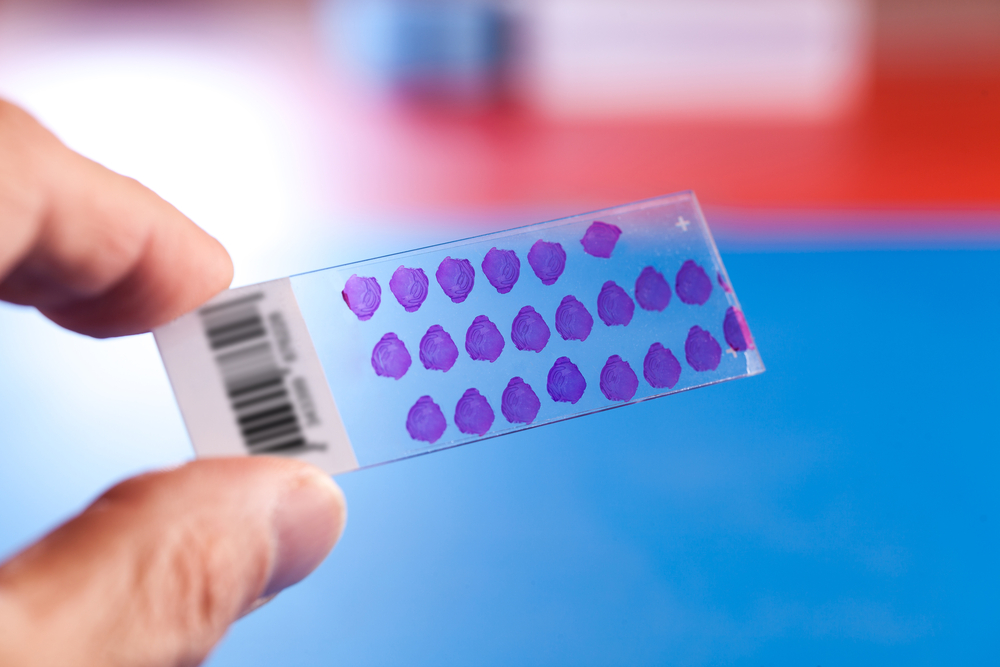Research conducted by scientists at Sweden’s Ume University and presented at the American Association for Cancer Research ( AACR) Annual Meeting 2015, held April 18-22 at the Pennsylvania Convention Center in Philadelphia found that a routine blood test to monitor for presence of rearrangement of the EML4-ALK (anaplastic lymphoma kinase) gene fusion in patients with non-small cell lung cancer (NSCLC) may help clinicians predict the outcome of treating the disease with the drug crizotinib.
 “By using the platelets isolated from venous blood specimen collections, we have an opportunity to follow the therapy in real time by determining alterations occurring in the tumor during treatment, and this makes it possible to tailor the therapy for each patient,” says Jonas A. Nilsson, PhD, a researcher in the Department of Radiation Sciences at Ume University in Sweden. “As a complement to imaging modalities, we may help doctors to be informed on when the tumor starts to regrow, when to switch therapy, and whether second-generation ALK inhibitors may be effective.”
“By using the platelets isolated from venous blood specimen collections, we have an opportunity to follow the therapy in real time by determining alterations occurring in the tumor during treatment, and this makes it possible to tailor the therapy for each patient,” says Jonas A. Nilsson, PhD, a researcher in the Department of Radiation Sciences at Ume University in Sweden. “As a complement to imaging modalities, we may help doctors to be informed on when the tumor starts to regrow, when to switch therapy, and whether second-generation ALK inhibitors may be effective.”
A subgroup of patients with NSCLC harbor EML4-ALK rearrangements in their tumors, making them responsive to targeted treatment with the ALK inhibitor crizotinib (Pfizer trade name Xalkori). The U.S. Food and Drug Administration approved Xalkori in 2011 to treat a subset of patients with late-stage (locally advanced or metastatic), non-small cell lung cancers (NSCLC) who express the abnormal anaplastic lymphoma kinase (ALK) gene. Xalkori was approved under the FDA’s accelerated approval program, which allows the agency to approve a drug to treat a serious disease based on clinical data showing that the drug has an effect on an endpoint that is reasonably likely to predict a clinical benefit to patients.
Xalkori is approved with a companion diagnostic test that will help determine if a patient has the abnormal ALK gene — a first-of-a-kind genetic test called the Vysis ALK Break Apart FISH Probe Kit, marketed by Abbott Molecular Inc. of Des Plaines, Ill.
The ALK gene abnormality causes cancer development and growth. An estimated 1 percent to 7 percent of persons with NSCLC have the ALK gene abnormality. Patients with this form of lung cancer are typically non-smokers, and Xalkori works by blocking certain proteins called kinases, including the protein produced by the abnormal ALK gene. Xalkori is a pill taken twice a day as a single-agent treatment.
The most common side effects reported in patients receiving Xalkori included vision disorders, nausea, diarrhea, vomiting, swelling (edema), and constipation. Vision disorders included visual impairment, flashes of light, blurred vision, floaters, double vision, sensitivity to light, and visual field defects. Xalkori use has also been associated with inflammation of the lung tissue (pneumonitis), which can be life-threatening. Patients with treatment-related pneumonitis should permanently stop treatment with Xalkori. The drug should not be used in pregnant women. It is not known if XALKORI is safe and effective in children. For more on Xalkori safety and side-effects, visit: http://bit.ly/1boRBjj
Xalkori’s safety and effectiveness data were established in two multi-center, single-arm studies enrolling a total of 255 patients with late-stage ALK-positive NSCLC. A sample of a patient’s lung cancer tissue was collected and tested for the ALK gene abnormality prior to study enrollment. The studies were designed to measure objective response rate, the percentage of patients who experienced complete or partial cancer shrinkage. Most patients in the studies had received prior chemotherapy.
In one study, the objective response rate was 50 percent with a median response duration of 42 weeks. In another, the objective response rate was 61 percent with a median response duration of 48 weeks.
However, while the drug is effective in these patients, an American Association for Cancer Research (AACR) release notes that many will eventually develop resistance to Xalkori.
In the UME University study, Dr. Nilsson and colleagues analyzed the efficacy of a blood-based liquid biopsy for assessing EML4-ALK’s presence in blood platelets of patients with NSCLC. Unlike assessment with advanced imaging techniques, computed tomography for example, the researchers theorized that a liquid biopsy would allow for real-time monitoring of the disease and earlier identification of patients who have developed resistance to treatment.
The research team analyzed blood samples from 77 patients with NSCLC with known mutation status, and found that among that cohort, 38 had EML4-ALK rearrangements in the tumor. The “liquid biopsy” identified 65 percent of the patients as having confirmed EML4-ALK rearrangement. In the 29 patients treated with crizotinib, those whose blood test was EML4-ALK-positive had a progression-free survival of 3.7 months compared with 16 months in those with EML4-ALK-negative blood tests.
“We showed that if we detected EML4-ALK in the platelet fraction before therapy starts and it does not disappear during treatment,” Dr. Nilsson observes. “It indicates that the patient is not responding to the therapy, which is associated with a shorter time to recurrence and, therefore, other therapies could be tried.”
Finally, in a case study of a patient followed for 2.5 years during crizotinib therapy, the researchers detected presence of EML4-ALK in the liquid biopsy two months before disease progression could be confirmed using standard imaging modalities.
[adrotate group=”10″]
“This study shows that platelet-powered diagnostics may add another layer of information to clinicians, and this information can be used to help in the clinical decision-making process,” says Dr. Nilsson. “Therefore, the platelet platform is an interesting biosource for the next generation of liquid biopsies and in the development of personalized health care.”
Conducted as an international collaboration between Amsterdam, Barcelona, Boston, and Ume, the study was funded by the European Research Council, the Dutch Organization of Scientific Research, the U.S. National Institutes of Health, CFF Norrland (RJAN), the Swedish Research Council (RJAN), the La Caixa Foundation, and the Redes Temticas de Investigation en Cancer. Dr. Nilsson is a co-founder and shareholder of thromboDx B.V.
Ume University is ranked 24th in the world of universities under 50 years old, and 1st in the Nordic countries. Ume’s two campuses are located in the city of Ume, which is the largest city in northern Sweden. The University Library boasts 1.2 million volumes, and the university also has a presence in many other towns and municipalities in northern Sweden, including Lycksele and Kiruna. In addition, thousands of people who are enrolled in Ume U.’s wide selection of distance education courses and programs have the flexibility of primarily studying in their home environments. The university’s total enrollment, including at the postgraduate level — is approximately 34,200 — more than 9,000 of whom are taking courses via distance education, or off-campus. Additionally, there are 2,146 teachers and researchers employed by the university.
Sources:
American Association for Cancer Research (AACR)
U.S. Food and Drug Administration
Pfizer
Ume University
Wikipedia

